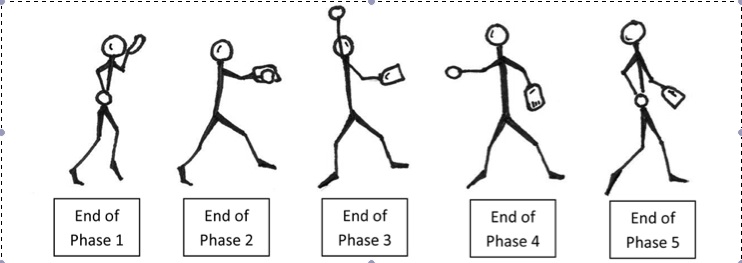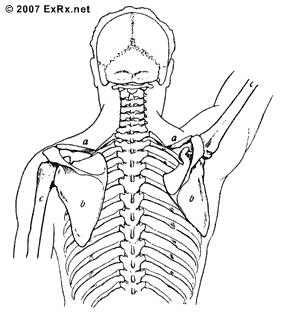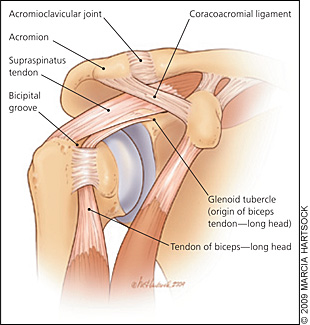Should softball pitchers have specific Strength & Conditioning programs to address the windmill pitch? Well, we all know that baseball pitchers are a very specialized position and should be trained in a very specific way. It's not uncommon for baseball pitchers to go to pitching coaches, physical therapists, chiropractors, message therapists, and strength coaches. There's 40+ years of research devoted to the mechanics of baseball pitching and there are lots of facilities devoted to just training baseball pitchers. Can you say high maintanence?? On the other hand, there are thousands of softball pitchers that aren't sharing in the love. Most competitive softball pitchers do have a pitching coach, but what about the other specialties? Let's look at why softball pitchers are getting injured so often and see how strength coaches can be a key element in their success.
People have argued for years that underhand pitching places much less stress on the shoulder. This may not, in fact, be true. One of the biggest reasons pitching (both baseball and softball) is so stressful on the body is because of the high demands of deceleration. A baseball pitcher pitches from an elevated mound and has more of a controlled fall. With softball, a pitcher does not pitch from an elevated mound and so must decelerate her arm as well as her body in a fairly abrubt fashion. This is called posting and it occurs when the stride leg "posts" to stop the forward motion. Common injuries in softball players include tendinitis, rotator cuff and tendon strain, and ulnar nerve damage, but there are also plaguing lower body injuries that affect softball pitchers. So what is the source of injury? In simplest terms, the hips provide the platform for the scapula, and the scapula is the platform for the shoulder. If there is dysfunction in that system, this leads to injury. If a pitcher complains of shoulder pain, the shoulder may not be at fault for the pain, but rather faulty mechanics in the lower body.
Hips - Platform for - Pelvis
Pelvis - Platform for - Torso
Torso - Platform for - Scapula
Scapula - Platform for - Shoulder
Many times, softball pitchers experience upper body injuries that may be a result of faulty lower body mechanics. Force is produced in the ground, transfers through the legs and torso, and finishes in the upper body. If something along those lines isn't functioning properly, injury will present itself. There are essentially 5 phases to the windmill pitch. This would be a really long article if we got into all the details, so let's take a look at the short and sweet version that shows muscle activity. (Photo below - Athletic Therapy today, November 2010)

Phase 1: High Gluteus maximus activity (stabilizing pelvis), rhomboids (weight is shifted, arm is at 6 o'clock)
Phase 2: High scapular stabilzer activity (rhomboids), infraspinatus (arm moves upward to 3 o'clock)
Phase 3: High Gluteus medius activity, posterior deltoid, infraspinatus, teres minor, rhomboids (arm moves from 3 to 12 o'clock)
Phase 4: High Gluteus medius activty, serratus anterior, biceps (arm moves from 3 to 9 o'clock)
Phase 5: High Pectoralis major, subscapularis, serratus anterior (arm moves from 9 o'clock to ball release)
From a Strength & Conditioning perspective, what does this mean? We need to start at the ground first because all enegy is transferred from the ground up to the hand (the final point of contact with the ball). We know that softball players pitch off a flat mound, whereas baseball players pitch off an elevated mound. Some studies have shown that ground reaction forces in softball pitchers are equal and possibly greater then baseball pitchers, probably due to the difference of mound heights. That means we need to train softball pitchers to increase ground reaction forces, as well as be able to controll them. If we go back to our platform analogy, we can see that the hips provide a platform for the pelvis. That means that a proper S & C program will have an emphasis on glute max and glute med exercises. Strong glutes will provide a strong base for the pelvis, then transferring energy through the core to the upper body. Some studies show that the legs and trunk provide between 51–55% of the total kinetic energy required for a pitch.
Energy must be transferred from the hips to the upper body, so the next link is the core. Some would say there needs to be an emphasis on rotational core exercises, but in reality, there is very little rotation in the core during a softball pitch. There is enough rotation in the hips to warrant some rotational exercises, but this probably shouldn't be the main focus of the S & C program. Check out this video of Becca, a pitching coach at Powerline Consulting, pitching.
If you can see from the video, Becca's plant leg (left leg) is used to resist excessive rotation. I would argue stabilizing the core could be more important then creating rotation in the core. From a S & C perspective, anti-rotation exercises would be an important component of training, as well as a few rotational exercises. The transverse abdominis and internal/external obliques play a role in transferring energy from the lower body to upper body. This would be an important part in a S & C program. If you are like me, you might need to see Becca pitching in slow motion, so check this one out:
Moving to the upper body, elevating the arm overhead to the 12 o'clock position requires the scapular stabilizers to fire. The scapular stabilizers include the rhomboids, serratus anterior, traps and leveator scapulae. The scapula must be stable in order to provide efficient movement in the shoulder, arm and wrist. You can see from the picture below how the scapula must slide to the right and rotate up so the arm can get to the overhead position.

If the scapula was unstable, it could allow the glenohumeral joint to move upward, potentially causing impingement. An article from the NSCA says "Scapular movement during the pitching motion allows for elevation of the acromion; thus, the scapular stabilizers must efficiently fire in an attempt to rotate the scapula so that it can clear the acromion for the function of the rotator cuff musculature." Essentially this means that you need to be building scapular stabilization during your S & C workouts, especially in the overhead position.
Anterior shoulder pain is one of the most common complaints among windmill pitchers. If we look at overall shoulder motion, a typical overhand pitch sees around 108 degrees of motion, whereas the windmill pitch has around 360 degrees of motion. This could have many implications, but of importance now is the increased eccentric action of the biceps. The highest biceps activity has been measured during the 5th phase of the windmill pitch (from the 9 o'clock position to the point of release). As you can see in the picture below, the head of the biceps inserts in an area between the subscapularis and supraspinatus (both muscles of the rotator cuff). From an S & C standpoint, the take home here is that a strength program should train deceleration of the arm.

Different pitches can stress the body in other ways as well. Check out this video of Becca throwing a curveball and look at the potential strain it places on her elbow.
Becca is a pro at throwing a curveball, so she limits the torque on her elbow. However, I have seen lots of her junior high and high school pitchers throw a curve and it looks nothing like this. Their elbows flare out and they use a lot of internal rotation at the shoulder to get that whip that Becca gets. This can lead to shoulder or elbow pain because of the eccentric loading and stretching of the posterior shoulder. The posterior shoulder has to do a lot of work to keep the humeral head properly seated in the glenoid.
No matter how you look at it, pitching over and underhand are both fairly unnatural motions for the body. But, that's the way the sport has developed over the years, and so it is the role of a proper Strength & Conditioning program to combat these unnatural movements. Part II of this article will go into specific exercises pitchers should be doing to prevent injuries, increase throwing velocity, and ultimately increase their sport performance.
References:
Lower extremity ground reaction forces in youth windmill softball pitchers (NSCA 2009)
Biomechanics of Windmill Softball Pitching With Implications About Injury Mechanisms at the Shoulder and Elbow (JOSPT 1998)
The Windmill Softball Pitch: Optimal Mechanics and Pathomechanics of Injury (Athletic Therapy today 2010)
Biceps Activity During Windmill Softball Pitching: Injury Implications and Comparison With Overhand Throwing (American Orthopedic society for Sports Medicine 2009)

